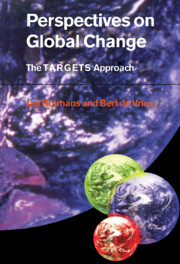Foreword
Published online by Cambridge University Press: 06 July 2010
Summary
The National Institute of Public Health and the Environment (RIVM) is a centre of expertise that provides support to the Dutch government in the development of its National Environmental Policy. The relationship between economic activity in the past and projections for the future, as well as the implications for health and the environment, are quantified by means of simulation models in scenario-based studies. These models deal with a wide range of issues, ranging from local air and soil pollution to climate change. Integration of the models, which are defined ‘bottom-up’, enables ‘integrated assessment’ of alternative future environmental policies. Integrated assessment, however, cannot be based on a ‘bottom-up’ approach alone. As early as the 1980s, RIVM developed the IMAGE model which takes a ‘top-down’ approach, to describe climate change. This model, and the IMAGE 2.0 version, that was developed subsequently, have made a substantial contribution to the assessment rounds of the Intergovernmental Panel on Climate Change (IPCC). It was felt, however, that issues related to sustainable development, as discussed during the 1992 Rio Conference, should be more integrated. As a first step, RIVM cooperated with Dennis and Donella Meadows of the University of New Hampshire on a re-evaluation of their book Limits to Growth, which was presented to the Club of Rome in 1971. The results of this cooperation were published in 1992 in the book Beyond the Limits.
- Type
- Chapter
- Information
- Perspectives on Global ChangeThe TARGETS Approach, pp. xi - xiiPublisher: Cambridge University PressPrint publication year: 1997

